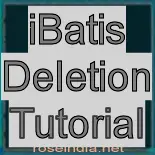iBatis Deletion Tutorial
I hope you have completely understood how to insert and show data from database in the previous examples. So in this example you will learn how to delete the data from database using iBatis. For that you have to analysis the code to understand clearly what is happening in this code. But you absolutely need not to create different database, as you already know that we are using previous MySQL as a database table and our table name is ?Contact?. But you have a choice you can use either this database or create your own it?s completely up to you! The only thing is that make sure you defined table name correctly otherwise bug will occur. In case you are following this iBatis tutorial from the starting then you need not to rewrite the code. Just copy the given code into folder and execute it finally to delete the data from the database table.
As I earlier mentioned.. In this section of iBatis tutorial we are going to delete records from Contact table, we are using MySQL database "vin".
Our Contact.java and SqlMapConfig.xml files are same as in previous examples.
Contact.java
public class Contact {
|
SqlMapConfig.xml
| <?xml version="1.0" encoding="UTF-8"?> <!DOCTYPE sqlMapConfig PUBLIC "-//ibatis.apache.org//DTD SQL Map Config 2.0//EN" "http://ibatis.apache.org/dtd/sql-map-config-2.dtd"> <sqlMapConfig> <settings useStatementNamespaces="true"/> <transactionManager type="JDBC"> <dataSource type="SIMPLE"> <property name="JDBC.Driver" value="com.mysql.jdbc.Driver"/> <property name="JDBC.ConnectionURL" value="jdbc:mysql://192.168.10.112:3306/vin"/> <property name="JDBC.Username" value="root"/> <property name="JDBC.Password" value="root"/> </dataSource> </transactionManager> <sqlMap resource="Contact.xml"/> </sqlMapConfig> |
In Contact.xml file we are using <delete> tag to delete all records from Contact table.
|
<delete id="deleteAll" parameterClass="Contact"> delete from Contact </delete> |
Above lines of code deletes all records from Contact table. Here the defined id "deleteAll" will be used further in IbatisDeletion class to execute query on the database.
Contact.xml
| <?xml version="1.0" encoding="UTF-8"?> <!DOCTYPE sqlMap PUBLIC "-//ibatis.apache.org//DTD SQL Map 2.0//EN" "http://ibatis.apache.org/dtd/sql-map-2.dtd"> <sqlMap namespace="Contact"> <!--- Delete data from Contact table --> <delete id="deleteAll" parameterClass="Contact"> delete from Contact </delete> <!--- Showing all data of table -->
|
We have imported following packages :
- com.ibatis.common.resources
- com.ibatis.sqlmap.client
for using classes and interfaces of SQL mapping .
Reader reader = Resources.getResourceAsReader("SqlMapConfig.xml");
|
Above lines of code reads configuration from "SqlMapConfig.xml". Full source code of IbatisDeletion.java is as follows:
IbatisDeletion.java
import com.ibatis.common.resources.Resources;
|
To run this example follow these steps :
- Create and save Contact.xml and SqlMapConfig.xml
- create and save Contact.java and compile Contact.java
- create IbatisDeletion.java and compile it
- execute IbatisDeletion and you will get following output on your command prompt
Output:




